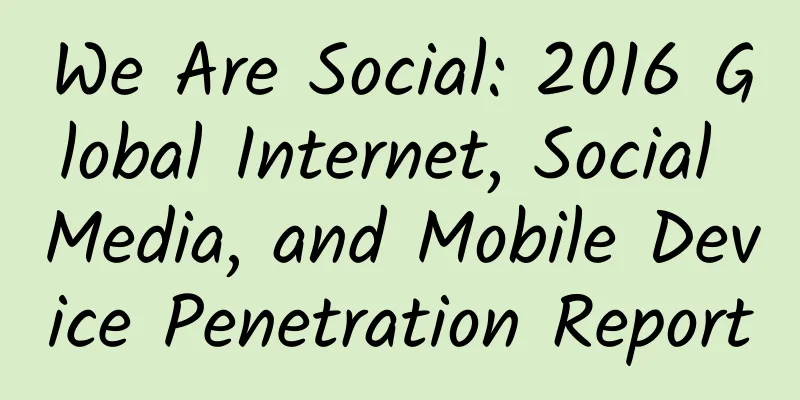We Are Social: 2016 Global Internet, Social Media, and Mobile Device Penetration Report

|
199IT original compilation We Are Social recently released the latest "2016 Digital Report", which comprehensively investigates the use of the Internet, social networking and mobile around the world. We Are Social had predicted significant growth in internet-related usage, but the new report for 2016 shows even faster growth, especially considering that global internet penetration is already approaching 50%. Key Internet, social and mobile media statistics for 2016 include:
As mentioned above, the growth is quite significant. It is worth noting that part of the growth in the number of Internet users is due to improvements in reporting accuracy. Comparing with the data from 2015, we can see more clearly how fast the growth rate is:
As the data of the past two years show, the growth rate of mobile social users is amazing, and the growth rate of mobile social users in this year's report once again stands out. However, the situation this year is slightly different, which we will analyze in detail later. Some are happy while others are sad. There are increases and decreases. The number of mobile phone registrations has declined in a few countries. This may be because as devices and networks improve, people upgrade to smartphones and no longer have to hold multiple mobile phone cards to get cheap on-network calls and SMS. Some countries also saw a decline in Facebook usage, especially in Africa. Countries with significant declines included the Central African Republic, where Facebook monthly active users fell 30% year-over-year; Western Sahara, down 24%; and Zimbabwe (down 16%). Outside of Africa, Monaco also saw a 15% drop in active Facebook users; and Serbia saw a 10% drop in Facebook users. internet The figure below shows the Internet penetration in major regions of the world. Internet development is uneven in different regions of the world. The Middle East is developing fastest, with an annual increase of 17% in Internet users and 21 million new Internet users in the past 12 months. As expected, Asia Pacific is the region with the largest absolute number of new Internet users, with 200 million new Internet users in the past 12 months, an annual growth rate of 12%. By this calculation, the number of new Internet users in Asia Pacific reached 500,000 for the first time in the past 12 months, equivalent to 6 new Internet users per second. In terms of country rankings, Iceland has the highest Internet penetration rate, with Internet users accounting for 98% of the total population (50,000 people), followed by Bermuda and Norway, with Internet penetration rates reaching 97% and 96% respectively. On the other hand, North Korea has the lowest Internet penetration rate in the world, with only 7,000 people having access to the Internet (North Korea has no Internet service providers, so this index is the number of Facebook users in North Korea). Internet penetration rates in many African countries are still relatively low, with Niger and Chad ranking second and third from the bottom, with penetration rates of only 2% and 2.5% respectively. Among the world's 30 major countries, the United Arab Emirates has the highest Internet penetration rate (96%), followed by the United Kingdom (92%) and Canada (91%). India and Indonesia have the lowest Internet penetration rates, accounting for 28% and 34% respectively, and these two countries are the only two countries among the 30 major countries whose Internet penetration rates are lower than the global average (46%). Among the 30 major countries, Brazilians and Filipinos spend the most time on the Internet, averaging 5.2 hours per day. Thais and Brazilians also spend the most time on mobile Internet, averaging 3.9 hours per day. Japan and South Korea are the countries with the shortest Internet usage, with an average of 2.9 and 3.1 hours per day respectively. Meanwhile, mobile’s share of global web traffic continues to grow, with StatCounter reporting that mobile phones now account for 39% of web page visits (browsers only). This year, PC and laptop website traffic has increased in some countries, partly because netizens use applications to access websites, making web traffic calculation more complicated. Among the 30 major countries, Nigeria has the highest mobile share of website traffic, with more than 80% of web page visits coming from mobile phones. On the other hand, Russia has the lowest mobile share of website traffic, at only 12%, which is equivalent to 1/3 of the global average. Internet speeds continue to improve, albeit slowly in many developing countries. South Korea has the fastest internet speed in the world (20.5 Mbps), 33% faster than second-place Hong Kong. Egypt, Nigeria, India, and the Philippines are still struggling to improve their internet speeds, with average speeds below 3 Mbps. The increase in Internet speed has also driven the development of e-commerce usage. GWI data shows that at least 25% of the population in major countries other than India have shopped online in the past month. The UK ranks first, with more than three-quarters of the population having shopped online in the past month. Social Media Currently, nearly one-third of the world's population uses social media, with an annual growth rate of 10%. North America is the region with the highest penetration rate of social network users (59%), and in South America, more than half of the population visits Facebook every month. (The data does not include Internet users under the age of 13). Although the number of social media users in Central Asia and South Asia has increased, the penetration rate is still low, accounting for 6% and 11% respectively. In terms of country and region rankings, Taiwan has the highest social media penetration rate, with 77% of the population having visited Facebook in the past 30 days; South Korea ranks second, with 38.4 million people (out of a total population of 50.4 million) regularly using KakaoTalk. On the other hand, North Korea is the country with the lowest social media penetration, with about 6,800 users (out of a total population of over 25 million). Turkmenistan ranks second from the bottom (0.2%). Filipinos spend the most time on social media, visiting for an average of 3.5 hours a day; Japanese are the least likely to use social media, visiting for an average of 20 minutes a day. Facebook still dominates the global social media platform with over 1.5 billion active users. However, WhatsApp, another service owned by Facebook, has seen significant growth in the past 12 months, with a 50% increase in users. It is expected that WhatsApp will have more than 1 billion users in a few weeks. Moreover, GWI data also shows that WhatsApp has surpassed Facebook in some countries. Obviously, this trend will spread to more countries in 2016. Facebook Messenger, another chat platform owned by Facebook, is also growing rapidly, with more than 800 million active users. Social media is not just about Facebook, Chinese social platform Tencent is also growing. The number of active accounts on the QQ messaging platform grew to 860 million in the fourth quarter of 2015. However, given that a person can have multiple accounts, this figure does not accurately describe QQ's popularity. Tencent’s other two platforms, QQ Space and WeChat, are also growing, with each reaching 650 million active users in the fourth quarter of 2015. WeChat is expected to surpass QQ Space in early 2016. Although Facebook dominates social media in most countries, there are exceptions. For example, the most popular social media in Russia and its neighboring countries is VKontakte; LINE is the most popular social network among Japanese, with a penetration rate of 42%; KakaoTalk dominates South Korea, with a penetration rate of 76%. Looking around the world, Tumblr and Instagram are two social media that are growing rapidly. Instagram, a simple social media, has reached 400 million monthly active users. Mobile social media Considering that KakaoTalk is the most popular in South Korea, it is no surprise that South Korea is the country with the highest mobile social media usage in the world. Qatar ranks second, with two-thirds of the population accessing social media through mobile devices. More than a quarter of the world’s mobile social media users live in East Asia. This is partly due to China’s large population base, and partly due to the good infrastructure in the Asia-Pacific region. Mobile social media is also popular in Southeast Asia, with Indonesia, Malaysia, the Philippines, Thailand and Vietnam all using mobile devices to access social media. 85% of Facebook users access the site via mobile, with 83% using smartphones and 2% using feature phones. This is a significant change from nine months ago, when 69% of users accessed the site via smartphones and 26% via feature phones. Globally, more than half of Facebook users only access the site on mobile devices and never on PCs. The global internet user’s love for instant messaging apps has a more profound impact on marketers. In addition to WeChat, platforms such as WhatsApp, LINE, KakaoTalk and Facebook Messenger are mostly private platforms and are rarely shown to strangers. cell phone Among the 30 major countries, Spain (87%), Singapore (85%) and Japan (84%) have the highest mobile phone user penetration rates; only eight countries have a registered mobile phone penetration rate below 67%, which once again emphasizes how quickly mobile phones have penetrated into people's lives. Western Europe has the highest ratio of registered mobile phone cards to population (139%), while the ratios in South Asia (77%), Africa (82%) and Central America (88%) are below 100%. In terms of countries and regions, Macau has the highest ratio of registered mobile phone cards to population (313%); on the other hand, Micronesia has the lowest ratio, only 4%. Mobile phones are not just a communication tool, but an important device for many people, allowing them to access a wealth of information and entertainment at their fingertips anytime and anywhere. Therefore, the share of mobile phones in network traffic continues to grow. On the other hand, this has also accelerated the development of mobile data consumption, with Ericsson reporting that the average smartphone user uses 1.4 Gb of data per month. Globally, mobile phones generate more than 4.5 exabytes of data per month, equivalent to 4.5 billion gigabytes, or more than 1,700 gigabytes per second. But the most important data point for marketers is mobile commerce, which grew by more than 50% in 30 major countries over the past 12 months. Among these countries, South Korea has the highest mobile commerce penetration, with GWI reporting that 43% of South Koreans have made a purchase using their mobile phones in the last month. Mobile commerce is also huge in China. On Singles’ Day in November 2015, e-commerce giant Taobao reported that 69% of its sales (totaling $14.3 billion) came from mobile devices, about $10 billion, more than double the online sales on Black Friday in the United States. The increase in mobile e-commerce usage is mainly due to the improvement of mobile broadband connections. We compared the ratio of broadband connections to population, and Macau (308%) ranked first, followed by Kuwait. The ratio in Central African Republic, Guinea, Niger and Tonga was only 1%. However, the good news is that global mobile broadband connections have doubled from last year, growing from 23% to 46%. China 199IT.com Originally compiled from: We Are Social. Please do not reprint without authorization |
<<: ABI Research: iPad sales are expected to reach 68 million units in 2014
>>: Popular Science Stamp Collecting | Robert Koch and the Discovery of Tuberculosis
Recommend
Why do women snore when they sleep?
What is the reason why women snore? In daily life...
What medicine can I take to get pregnant immediately?
After the country implemented the policy of late ...
Problems with the incision of the second cesarean section
I believe many women pay special attention to the...
What is the function of coenzyme Q10 and who needs to supplement it?
Many friends have consulted Huazi about coenzyme ...
Is scoliosis hereditary?
In today's society, scoliosis has become one ...
What is udon? How long does it take to cook packaged udon noodles?
Udon noodles (Japanese: うどん, English: udon, writt...
Does increased vaginal discharge after ovulation mean pregnancy?
Increased vaginal discharge after intercourse dur...
What are the fetal development indicators during pregnancy?
Every child is the most precious treasure in the ...
Episiotomy anal pain
Many people choose to give birth naturally, but s...
What should I do if a 16-year-old girl has no breast development?
Breasts are a typical feature of us women and one...
What should I do if I keep spitting up during pregnancy?
Some women find that they are always coughing up ...
Is it good to eat dragon fruit after abortion?
Abortion is a method that women choose when they ...
Do "star drugs" such as statins cause cancer? Don't believe it.
Produced by: Science Popularization China Produce...
How to treat cervical hypertrophy caused by vaginitis? Chinese medicine treatment is effective
Vaginitis is a common gynecological inflammation....
How to control weight during the fifth month of pregnancy
Pregnancy is the top priority in a woman’s life. ...









